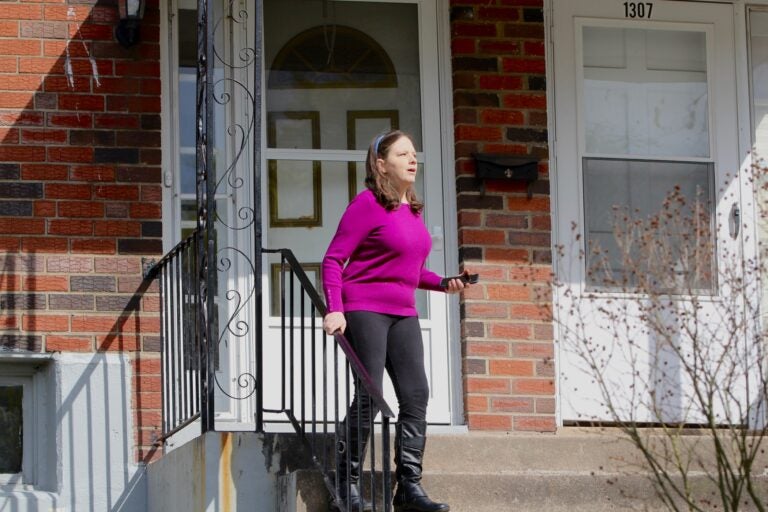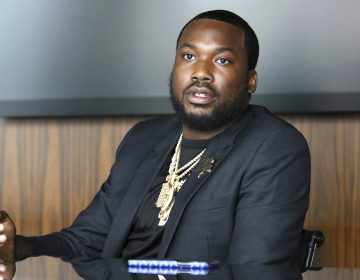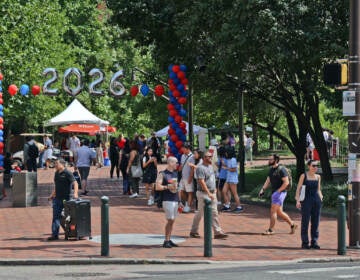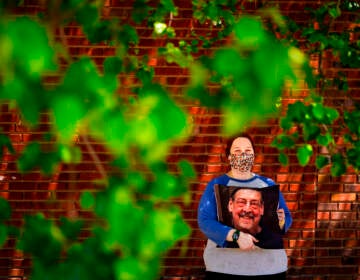What it’s like to be disabled now, in the middle of the coronavirus pandemic
People who are disabled or have chronic illnesses have a different perspective on the limits we’re all living with today.

Angie Staudt steps outside her home in Brookhaven, Pa. (EmmaLee/WHYY)
Angie Staudt used to enjoy shopping. As it has for many people, that’s become something to endure since the start of the COVID-19 pandemic.
Staudt has been blind since birth, so following social distancing measures like staying 6 feet away from other shoppers is pretty much impossible without help.
“I hear, ‘Back up, back up, you’re too close.’ That’s my clue that I’ve crossed the 6-foot barrier … I just don’t know where that barrier is.”
Now, she said, she sometimes also needs help knowing where the checkout line is. Some grocery stores have changed their layouts so there is only one entrance, one exit, and one line that feeds to all the checkout lanes.
Some stores have marked off 6-foot spaces with yellow tape. But that isn’t tactile enough for blind people to feel with their feet, like the bumpy rumble strips near train platforms, so the tape only works for sighted people.
“You have to kind of hope that people are kind enough to tell you,” she said, “and mostly people are kind enough to tell you most of the time.”
Staudt shops for her three-person household, and goes to a supermarket in Delaware County where the staff know her by name. But she worries whether a new blind customer would be able to get help.
Normally, Staudt said, she shops online, but that has been harder recently because so many more people are as well, increasing delivery and wait times.
“I get why people are online shopping, it makes sense,” she said. “On the other hand, if lots of people are online shopping who could get in their car and go, and follow those guidelines … and follow the marks on the floor … consider carefully, ‘Do I need to shop online?’ ‘Am I taking this spot from someone, maybe an older person who can’t or shouldn’t be out?’”
One nice thing with the pandemic is that fewer people are grabbing her to try to help without asking.
“Anybody who was sighted who was touched randomly … would stop and say, ‘Why are you touching me?’ When I say that, I’m viewed as ungrateful, as a harsh person,” she said. “I appreciate your offer to help, but how about you ask … before you just reach out and grab, because a lot of times it’s just reaching out and grabbing.”
Jennifer Wilgus, who is blind and has two children, said it would be nice if more people would offer to help by asking, instead of just walking past her when she stands around trying to find the line at a store.
She used to get help with grocery shopping and reading her mail from the Center for the Blind and Visually Impaired, a service agency for the blind community. However, in-person services have been suspended, so she has to video chat with a family member or use an online platform like Aira so someone can read her mail to her.
That includes important letters about child insurance, and Social Security and other benefits. Not all the agencies sending those letters include alternatives for the blind.
A ‘new normal’ for some, not so new for others
For some other individuals with disabilities or chronic health problems, the coronavirus crisis has simply highlighted already-existing issues — some of which they’ve dealt with for years.
Terri Burgin was diagnosed with lupus, an autoimmune disease, four years ago. For her, the so-called “new normal” of quarantine isn’t particularly new at all.
“When this first started, the protocols that we were talking about – of wiping off surfaces or washing your hands, of just being mindful of how you touch your face — that was already my everyday life,” she said.
Lupus, as well as the immunosuppressants prescribed to control it, weaken the body’s immune system. That means that Burgin, who’s 36, is both much more likely to get sick from an infection, and to suffer complications related to that infection. In a pandemic that most severely affects the elderly and immunocompromised, the stakes are even higher.
“[This is] what I have to live with on a regular basis … what thousands of Philadelphians are living with on a regular basis,” she said. “The coronavirus has just taken it to another level.”
Embry Wood Owen is an organizer and researcher who specializes in disability justice. On one hand, she said, the societal shift to remote work, more flexible scheduling, online events, and expanded delivery options from typically inaccessible establishments is exciting; they open up possibilities for inclusion of disabled individuals whose needs were previously overlooked.
At the same time, Owen said, it’s telling that these issues weren’t recognized or addressed until they adversely affected able-bodied people.
“We’ve been long denied those accommodations and those requests … we were told [our access] wasn’t possible, it wasn’t feasible, and now, apparently, it is,” Owen said. “I think there’s been some frustration and resentment that it took a pandemic for these things to be put in place.”
Medical professionals in increasingly packed hospitals are being forced to make life-or-death decisions about whose lives matter. Whose symptoms are “severe” enough to warrant a test? Whose health is most at risk? Who should get prioritized for an ICU bed or a ventilator?
The federal government has released a document about non-discrimination during the pandemic. Pennsylvania Gov. Tom Wolf issued a similar one last month committing to allocate life-saving care equitably. But prominent disability advocates say that isn’t necessarily enough. They’re worried about state guidelines given to medical professionals about rationing care, and the fact that those guidelines may deprioritize vulnerable people — particularly those with cognitive disabilities.
“Even the notion of ‘quality of life’ as a measurable standard is based on assumptions that a ‘good’ healthy life is one without disability, pain, and suffering,” Alice Wong, a disabled activist from California, wrote for Vox last week. “Disabled people are not acceptable collateral damage in this pandemic.”
“I think many people who live with disability already live with this idea that the medical system is not fully equipped to meet our needs and provide the care that we need or are relying on. So these concerns aren’t new, but they do feel increasingly urgent,” Owen said. “There’s a real gap between [how] a medical provider or someone who’s able-bodied might look at a disabled person and say this is their quality of life, versus the disabled person’s understanding of their own quality of life. And that’s hugely dangerous in this situation.”
As a 29-year-old survivor of brain injury, Owen’s disability isn’t primarily physical, and she’s not one of the populations at higher risk. So in the past month, she’s been channeling her time and energy into working with other organizers to build a mutual aid network centered in South Philadelphia, with a focus on disabled and chronically ill individuals. She says she’s seen many residents learning about and contributing to mutual aid networks for the very first time, which is encouraging.
“It’s something that disabled communities and communities of color across the world have been utilizing for a long time in order to take care of each other and sustain each other — knowing that government institutions are not going to preserve their well-being,” she said. “So that kind of interdependence and solidarity is going to be really important.”
WHYY is your source for fact-based, in-depth journalism and information. As a nonprofit organization, we rely on financial support from readers like you. Please give today.




![CoronavirusPandemic_1024x512[1]](https://whyy.org/wp-content/uploads/2020/03/CoronavirusPandemic_1024x5121-300x150.jpg)




